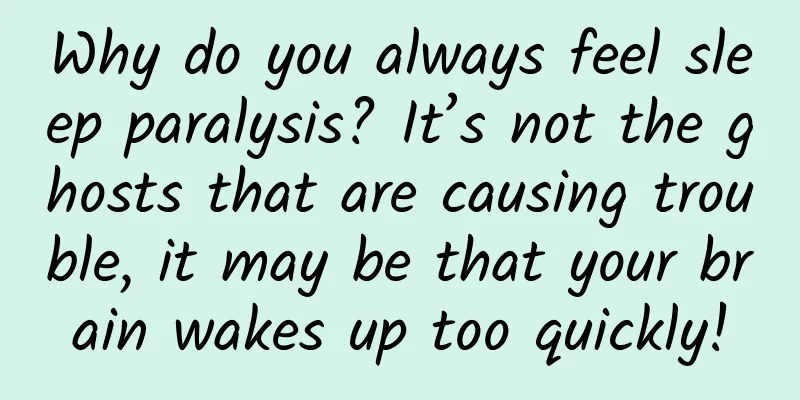Why do you always feel sleep paralysis? It’s not the ghosts that are causing trouble, it may be that your brain wakes up too quickly!

|
Have you ever had this experience: after waking up from a dream, you seem to be trapped in a gray area, your brain is fully awake, but your body seems to be pressed down by something heavy, your hands and feet cannot move, you can’t make a sound even if you want to shout, and you feel fear and suffocation in your heart... This is most likely an experience of sleep paralysis, which also has a scientific name, sleep paralysis . For centuries, people have been looking for an explanation for this mysterious phenomenon - whether it's the old witch in Shakespeare's "Romeo and Juliet", or stories about alien abductors, or in Chinese feudal superstitions, sleep paralysis is believed to be related to "evil" things. Nearly every culture throughout history has tales of dark, evil creatures that appear at night and strike terror into the hearts of helpless humans... But is this really the case? Image source: Reference [1] Why does sleep paralysis occur? The specific pathogenesis of sleep paralysis is not very clear. Since it usually occurs during the transition between sleep and wakefulness, it is currently believed that sleep paralysis is a sleep disorder caused by the overlap of rapid eye movement (REM) sleep and wakefulness. Human sleep can be divided into rapid eye movement (REM) and non-rapid eye movement (NREM) sleep. These two periods appear alternately, and each cycle lasts about 90 to 120 minutes. NREM sleep appears first, accounting for 75% of the total sleep time. At the end of NREM, it switches to REM. During rapid eye movement (REM) sleep, the eyeballs move rapidly and dreams occur. In order to prevent the body from performing dreams in response to the dream (such as punching, kicking, running, etc.), the brain controls the body's muscles to be completely relaxed. If you become conscious after the REM period but your muscles are still in a relaxed state, you may realize that your body cannot move. Simply put, your consciousness is awake, but your muscles have not had time to wake up. Image source: Reference [2] Who experiences sleep paralysis? Sleep paralysis is very common, with approximately 20% to 60% of the general population experiencing it at least once in their lifetime[3,4]. It can occur in people of any age and gender, and most patients experience sleep paralysis for the first time during adolescence. For most people, sleep paralysis is very occasional and not frequent, and may occur 1-2 times a year or several years[3]. Sometimes, sleep paralysis may also be related to genes, and multiple people in a family may experience sleep paralysis[5,6]. Other factors that may be associated with sleep paralysis include: • Lack of sleep • People with irregular work and rest schedules (such as those working in shifts) • People with mental disorders, such as stress or bipolar disorder • Supine • Other sleep problems, such as narcolepsy or obstructive sleep apnea These four conditions may not be simple sleep paralysis Sleep paralysis is diagnosed mainly based on clinical manifestations: if you find yourself unable to move for a few seconds or minutes when falling asleep or waking up, accompanied by a sense of fear and suffocation, you can usually be diagnosed with sleep paralysis. It should be noted that if you have any of the following four conditions, you must inform your doctor in time, as further detailed examination and diagnosis may be required: ① Sleep paralysis occurs frequently, such as 2 to 3 times a month or more ② Anxiety about recurring sleep paralysis symptoms ③Your symptoms make you feel very tired, sleepy and drowsy during the day ④Your symptoms keep you awake at night The doctor will fully understand your sleep condition, whether you have other types of sleep disorders, family history of sleep disorders, taking special medications, etc. If necessary, a nighttime sleep polygraph or a daytime multiple nap latency test may be arranged to rule out other sleep disorders, such as narcolepsy (the most common cause of sleep paralysis, and patients often experience sleep paralysis symptoms much more frequently than ordinary people) or sleep apnea. How can I take care of myself after a sleep paralysis episode ? It's natural to feel tired, emotional, and fearful after recovering from sleep paralysis. Sleep paralysis is a very frightening experience. Please be kind to yourself, get more rest, get enough sleep, talk to people, soothe your emotions and release stress. Image source: unsplash.com If you experience sleep paralysis occasionally, you can take steps at home to manage its occurrences. These include: • Make sure you get enough sleep; • Do what you can to reduce stress in your life – especially before bed; • If you normally sleep on your back, try changing your sleeping position. But if sleep paralysis disrupts your sleep or makes you feel terrible for a long time, be sure to see a doctor. Does sleep paralysis require treatment? Most cases of sleep paralysis are isolated (occur only once) or recurrent but infrequent (occur a few times a year or once every few years). In these cases, sleep paralysis does not require specific treatment. If you're anxious or have trouble sleeping, you may need to treat your mood disorder or an underlying condition like narcolepsy or sleep apnea to help relieve your sleep paralysis. • Improve your sleeping habits – for example, make sure you get 6-8 hours of sleep per night • Use of anti-anxiety and depression medications • Treat any mental health issues that may be causing sleep paralysis • Treat other sleep disorders such as narcolepsy and sleep apnea Generally speaking, sleep paralysis is quite common. Although it is commonly known as "sleep paralysis", it has nothing to do with ghosts and is usually not a serious problem and does not require treatment. If you occasionally have similar experiences, please don't be nervous or afraid. You can try to avoid sleep paralysis by adjusting your work and rest schedule, ensuring sleep, reducing stress, changing your sleeping position, etc. In rare cases, when sleep paralysis occurs particularly frequently, makes you anxious, and affects your sleep, you need to see a doctor to further find potential treatable causes and actively treat them. References [1] https://www.sleepcycle.com/sleep-paralysis/sleep-paralysis-what-was-that-thing-in-my-room/ [2] https://dreamstudies.org/guarding-the-threshold-the-use-of-amulets-and-liminal-objects-for-sleep-paralysis-night-mares/ [3] UpToDate - Clinical features and diagnosis of narcolepsy in adults [4] Blackmore Susan J., Parker Jennifer J. (2002). "Comparing the Content of Sleep Paralysis and Dream Reports". Dreaming. 12 (1): 45–59. [5] Avidan, Alon Y.; Zee, Phyllis C. (2011). Handbook of Sleep Medicine (2 ed.). Lippincott Williams & Wilkins. p. Chapter 5. [6] https://en.wikipedia.org/wiki/Sleep_paralysis#cite_note-Goldstein-11 Planning and production Source: Yihe Science Author: Zhou Qin, neurologist, Wuhan University People's Hospital Editor: Yinuo |
<<: How dazzling is the sun captured by Xihe?
>>: Primary school students’ “Buddhist style of skewers”, do you get it?
Recommend
NetEase Designer: How to design a banner that can make users pay?
We explore this in three dimensions: Data-driven ...
A guide to avoiding pitfalls in overseas marketing
How popular are brands going overseas? According ...
Authoritative interview! Detailed explanation of COVID-19 symptoms within 7 days of onset! How to quickly turn from positive to negative? A picture comparison →
The following article is from Beijing News Radio,...
Case review + fission methodology | Why is your fission activity ineffective?
The fission gameplay template is important, but w...
WeChat iOS version has been significantly updated: a new "group chat folding" feature has been added, and the forwarding and WeChat phone interface have also changed.
[[425948]] September 27 news: The iOS version of ...
Yu Yongfu: The Internet makes you run faster, but it is not the Internet that is the soul
In 2014, the term "market-to-dream rate"...
Bilibili video product analysis
Bilibili is a product that is very popular among ...
One man guards the pass, ten thousand men cannot open it: the small mouth actually hides such a complex ecological environment
Open your mouth in front of the mirror and look a...
Encounter spring and prevent fires: You need to know these spring forest fire prevention knowledge
Audit expert: Luo Huachun Director of the Natural...
A brief discussion on the design of bidding advertising mechanism
Regarding bidding ads , many people have two extr...
VIVO Z3 review: Waterdrop-shaped dynamic screen + dual-turbo acceleration, the screen king in the thousand-yuan phone market
The most important thing in mobile phone evaluati...
How did 100,000 yuan get 937 orders?
The author of this article is Liu Shuopei, deputy...
App channel promotion skills and strategies!
As we all know, the first step in App promotion i...
How can APP accurately discover users’ real needs?
Regarding user needs, there is a very famous case...
Some organisms have not changed in hundreds of millions of years. Has evolution really stagnated?
Some organisms seem to have remained unchanged in...









